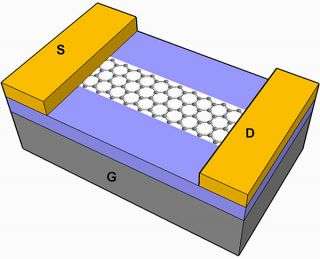Carbon nanoribbons could make smaller, speedier computer chips

Stanford chemists have developed a new way to make transistors out of carbon nanoribbons. The devices could someday be integrated into high-performance computer chips to increase their speed and generate less heat, which can damage today's silicon-based chips when transistors are packed together tightly.
For the first time, a research team led by Hongjie Dai, the J. G. Jackson and C. J. Wood Professor of Chemistry, has made transistors called "field-effect transistors"—a critical component of computer chips—with graphene that can operate at room temperature. Graphene is a form of carbon derived from graphite. Other graphene transistors, made with wider nanoribbons or thin films, require much lower temperatures.
"For graphene transistors, previous demonstrations of field-effect transistors were all done at liquid helium temperature, which is 4 Kelvin [-452 Fahrenheit]," said Dai, the lead investigator. His group's work is described in a paper published online in the May 23 issue of the journal Physical Review Letters.
The Dai group succeeded in making graphene nanoribbons less than 10 nanometers wide, which allows them to operate at higher temperatures. "People had not been able to make graphene nanoribbons narrow enough to allow the transistors to work at higher temperatures until now," Dai said. Using a chemical process developed by his group and described in a paper in the Feb. 29 issue of Science, the researchers have made nanoribbons, strips of carbon 50,000-times thinner than a human hair, that are smoother and narrower than nanoribbons made through other techniques.
Field-effect transistors are the key elements of computer chips, acting as data carriers from one place to another. They are composed of a semiconductor channel sandwiched between two metal electrodes. In the presence of an electric field, a charged metal plate can draw positive and negative charges in and out of the semiconductor. This allows the electric current to either pass through or be blocked, which in turn controls how the devices can be switched on and off, thereby regulating the flow of data.
Researchers predict that silicon chips will reach their maximum shrinking point within the next decade. This has prompted a search for materials to replace silicon as transistors continue to shrink in accordance with Moore's Law, which predicts that the number of transistors on a chip will double every two years. Graphene is one of the materials being considered.
David Goldhaber-Gordon, an assistant professor of physics at Stanford, proposed that graphene could supplement but not replace silicon, helping meet the demand for ever-smaller transistors for faster processing. "People need to realize this is not a promise; this is exploration, and we'll have a high payoff if this is successful," he said.
Dai said graphene could be a useful material for future electronics but does not think it will replace silicon anytime soon. "I would rather say this is motivation at the moment rather than proven fact," he said.
Although researchers, including those in his own group, have shown that carbon nanotubes outperform silicon in speed by a factor of two, the problem is that not all of the tubes, which can have 1-nanometer diameters, are semiconducting, Dai said. "Depending on their structure, some carbon nanotubes are born metallic, and some are born semiconducting," he said. "Metallic nanotubes can never switch off and act like electrical shorts for the device, which is a problem."
On the other hand, Dai's team demonstrated that all of their narrow graphene nanoribbons made from their novel chemical technique are semiconductors. "This is why structure at the atomic scale—in this case, width and edges—matters," he said.
Paper: link.aps.org/toc/PRL/v100/i20
Source: Stanford University




















